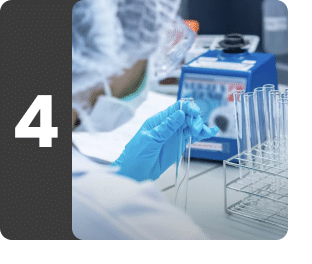Lipid Profile - Extended
Understanding Lipid Profile - Extended
What is Lipid Profile - Extended?
A lipid profile-extended test measures the amount of lipids (fats) in your blood. Too many lipids can lead to plaque buildup in your blood vessels, which can increase your risk of cardiovascular problems. Therefore, this profile is done as a part of a routine checkup to predict your risk of heart disease. This profile includes a range of tests such as triglycerides, high-density lipoprotein (HDL) and low-density lipoprotein (LDL) cholesterol, non-HDL cholesterol, very low-density lipoprotein (VLDL), total cholesterol, total cholesterol/HDL cholesterol ratio, lipoprotein A, apolipoproteins (A1 and B), apolipoprotein B/A1 ratio, and proteins (homocysteine and high-sensitive C-reactive protein). Measures such as eating heart-healthy food, exercising regularly to maintain body weight, and quitting smoking may help lower your cholesterol levels.
What does Lipid Profile - Extended measure?
Contains 12 tests
High Sensitive CRP
High-sensitivity CRP (Hs-CRP) test measures lower levels of CRP in the blood to predict the risk of Cardiovascular diseases and stroke.
Hs-CRP can implicate low level of inflammation. A persistent low level of inflammation can result in a build-up of cholesterol and other lipids and can cause atherosclerosis and narrowing of blood vessels, which is often associated with Cardiovascular diseases (CVD). The hs-CRP test accurately measures low levels of C-reactive protein to identify low but persistent levels of inflammation and thus helps predict a person's risk of developing CVD. High-sensitivity CRP along with lipid profile can be a useful test for screening the risk of CVD, heart attacks, and strokes. Studies have suggested that this test is best suited for people who have a moderate risk of heart attack over the next 10 years.
Therefore, Hs-CRP is generally advised along with other tests such as lipid profile and lipoprotein-associated phospholipase A2 (Lp-PLA2) to provide added information about the risk of heart disease.
Know more about High Sensitive CRP
Apolipoprotein - A1

Cholesterol - Total
Cholesterol is essential for life, as it is required by the body to work properly. It plays a role in the formation of cell membranes in all organs and tissues in the body. It is associated with the formation of hormones which are important for development, growth, and reproduction. It forms bile acids, which help to absorb nutrients from food.
In the blood, a small amount of cholesterol circulates in the form of lipoproteins which contains protein, cholesterol, triglyceride, and phospholipid molecules. These are classified according to their density into HDL (high-density lipoproteins), LDL (low-density lipoproteins), and VLDL (very low-density lipoproteins). HDL cholesterol is also known as good cholesterol, as it carries excess cholesterol away for disposal while LDL cholesterol is also known as bad cholesterol, as it deposits cholesterol in tissues and organs.
It is important to maintain and monitor the levels of cholesterol for a healthy lifestyle. The source of cholesterol is diet as well. If a person is taking too much of cholesterol-rich foods, it can cause a rise in levels of cholesterol in the blood. The amount of cholesterol which is not required by the body starts to deposit in the form of plaques on the walls of blood vessels. These plaques can narrow or block the blood vessels opening which can lead to the hardening of arteries known as atherosclerosis. Also, with an increase in cholesterol levels, there is an increased risk of various conditions such as heart disease and stroke.
Know more about Cholesterol - Total

Triglycerides
Triglycerides test measures the levels of triglycerides in the blood.
Triglycerides are a type of body fat (lipid). Chemically, triglycerides consist of three ("tri-") molecules of fatty acid combined with a molecule of the alcohol glycerol ("-glyceride").
High levels of triglycerides in the blood have been linked to atherosclerosis which increases the risk of heart disease (Coronary Artery Disease), peripheral artery disease, stroke and kidney disease. Atherosclerosis is a disease in which plaque (made up of fat, cholesterol, calcium, and other substances) builds up inside the arteries (blood vessels) resulting in narrowing of the lumen. This restricts the flow of blood to the organs and other parts of the body. Signs and symptoms of atherosclerosis usually do not appear until severe or total blockage of the artery (blood vessel). Therefore, most people are not aware of atherosclerosis until they have a medical emergency, such as a heart attack or stroke.
Increased levels of triglycerides may also be seen in Metabolic syndrome (cluster of metabolic risk factors for cardiovascular disease, type 2 diabetes and stroke). Very high triglyceride levels can also cause inflammation of the pancreas (pancreatitis).
Triglycerides test is usually done as a part of lipid profile which includes other tests like cholesterol, HDL (High-density lipoprotein), LDL (Low-density lipoprotein), VLDL (Very low-density lipoprotein) also.
Know more about Triglycerides
Cholesterol - HDL

Cholesterol - LDL
The cholesterol LDL test measures the levels of cholesterol LDL in the blood. LDL also known as low-density lipoprotein carries cholesterol in the blood. It consists mainly of cholesterol, similar other substances, and a small amount of protein.
It is very important to monitor and maintain healthy levels of lipids for staying healthy. Intake of foods that are high in saturated fats and trans unsaturated fats can raise the levels of cholesterol in the blood. The extra cholesterol gets deposited in plaques on the walls of blood vessels. This may result in atherosclerosis (hardening of the arteries). It can also increase the risk of various other health problems such as heart disease and stroke.
The cholesterol LDL is known as “bad cholesterol” as it gets deposited in the vessels as plaque, giving rise to cardiovascular diseases. The cholesterol HDL which is the high-density lipoproteins cholesterol is known as “good cholesterol” as its role is to transport cholesterol from the arteries to the liver and thus protects the body against heart diseases.
The cholesterol LDL test helps in determining the risk of heart disease in an individual. It also helps in planning out the treatment considering other known risk factors as well. The treatment can involve changes in lifestyle such as diet and exercise or lipid-lowering medications such as statins.
Know more about Cholesterol - LDL
Apolipoprotein B/A1 Ratio
Very Low Density Lipoprotein

Homocysteine
The Homocysteine Test measures the levels of homocysteine in the blood.
Homocysteine is an amino acid which is an intermediate in the production of cysteine from methionine. Methionine is obtained from dietary sources, mainly fish, meat, and dairy products, and is converted to homocysteine, and then to cysteine in the body. This conversion from methionine to cysteine is regulated by various enzymes which require Vitamin B6, B12, and folic acid to work. Deficiency of these vitamins causes an increase in the levels of homocysteine in the body. Increased homocysteine levels in the blood can be due to a rare genetic disease called homocystinuria, where the enzymes needed for methionine metabolism are dysfunctional.
Increased levels of homocysteine in the blood are associated with an increased risk of cardiovascular diseases including atherosclerosis, thrombosis (formation of blood clots) in blood vessels, heart attack, and stroke. It has also been implicated in some studies with an increased risk of Alzheimer’s disease.
Know more about Homocysteine
Apolipoprotein - B
Non HDL Cholesterol
Lipoprotein A
Book a Lipid Profile - Extended test at home near me





Other tests









